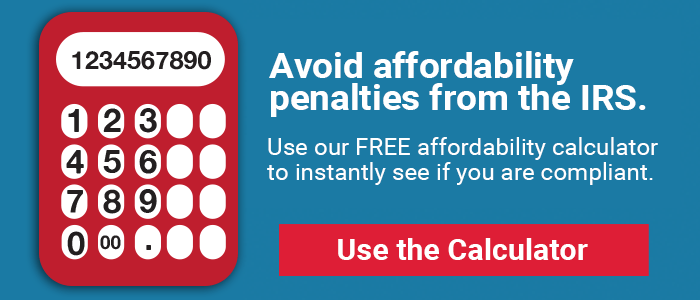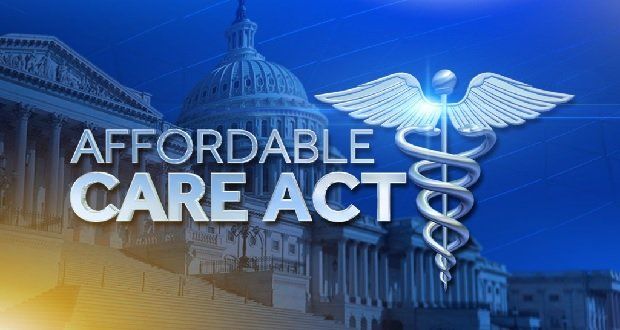ACA Affordability Penalty
Points North • May 14, 2019

There has been a lot of news the past couple of years regarding efforts to repeal the Patient Protection and Affordable Care Act, commonly referred to as the ACA. While the individual mandate was successfully repealed for 2019 and beyond (meaning that individuals who fail to have health insurance coverage will no longer have to pay a penalty), it’s critical for Applicable Large Employers (ALEs) to understand that the employer mandate is still in full effect for 2019 and beyond. That means that the penalties associated with not offering affordable coverage are also still in effect.
This blog will discuss the Affordability Penalty, which is one of the two penalties related to ACA, which provides that an ALE member may choose either to offer affordable minimum essential coverage that provides minimum value to its full-time employees (and their dependents) or potentially owe an Employer Shared Responsibility Payment (ESRP).
Potential ACA Penalties
An ALE member may be subject to one of two employer shared responsibility payments, but not both, and the two types of payments are calculated differently. An ALE member may not be subject to both types of payments regardless of the decisions it makes about offering or not offering minimum essential coverage to its full-time employees (and their dependents).
For either type of employer shared responsibility payment to apply to an ALE member, at least one full time employee must receive the premium tax credit for purchasing coverage through the Marketplace. In general, a full-time employee could receive the premium tax credit if:
The minimum essential coverage offered was not affordable,
The minimum essential coverage the employer offers to the employee does not provide minimum value, or
The employee is not one of the at least 95 percent of full-time employees offered minimum essential coverage.
What Does Affordable Coverage Really Mean?
Under the ACA regulations, Applicable Large Employers (ALEs) must offer affordable health insurance to at least 95% of their eligible full-time employees. In the context of ACA regulations, “affordable” means that the cost the employee would pay if self-only coverage was elected cannot exceed a specified percentage of the employee’s household income. This percentage is adjusted each year. For 2019, the percentage is 9.86%.
It’s important to note that even if the employee selects a different coverage option (such as self + family), affordability is still based on the employee-paid portion for the offered self-only coverage providing Minimum Essential Value and Minimum Coverage.
Since employers are not likely to know the household income of their employees, there are three safe harbors that an employer may use to determine affordability for purposes of the employer shared responsibility provisions. In general, under these employer shared responsibility affordability safe harbors, instead of using household income to determine affordability, employers are allowed to use:
Form W-2 Box 1 wages,
An employee’s rate of pay (which is calculated differently for hourly vs non-hourly employees), or
The federal poverty line for the tax year.
For more information about the safe harbors, follow this link to the IRS’s Question and Answer page and section 54.4980H-5 of the ESRP regulations.
What are the penalties for not offering affordable coverage?
An ALE member may be subject to one of two employer shared responsibility payments, but not both, and the two types of payments are calculated differently. For purposes of this blog, assume the ALE offered minimum essential coverage providing minimum value to 95% of its full-time employees (and their dependents).
Although expressed here as an annual number, the affordability employer shared responsibility payment is calculated on a monthly basis ($3,000/12 = $250 per month). The IRS will determine whether an ALE member owes this payment on a month-by-month basis. It is based on the number of full-time employees of the ALE member who receive the premium tax credit for purchasing coverage through the Marketplace because the coverage was not affordable.
On an annual basis, this payment is $3,000 (indexed for future years) for each full-time employee who receives the premium tax credit. The total payment in this instance cannot exceed the amount the employer would have owed had the employer not offered minimum essential coverage to at least 95 percent of its full-time employees (and their dependents).
The inflation adjustment beginning in calendar years after 2014 is increased based on the premium adjustment percentage (as defined in section 1302(c)(4) of the Affordable Care Act) for the year, rounded to the next lowest multiple of $10. As you can see, the adjustments to the $3,000 amounts have risen each year as follows:
For calendar year 2015, adjusted to $3,120
For calendar year 2016, adjusted to $3,240
For calendar year 2017, adjusted to $3,390
For calendar year 2018, adjusted to $3,480
For calendar year 2019, adjusted to $3,750
The Bottom Line
As you can see, the employer penalties for not offering affordable health insurance coverage can be costly and should not be ignored. To collect these payments, the IRS has been sending out 226-J penalty notifications for tax years beginning with 2015, and it is the employer’s responsibility to provide documentation showing that the employee should not have received a subsidy (that affordable coverage was offered to the employee).
To avoid these costly penalties, employers should ensure that they are offering affordable qualifying coverage and take all of the ESRP regulations into account when developing employee health insurance plan cost offerings. calculator CTA
This blog will discuss the Affordability Penalty, which is one of the two penalties related to ACA, which provides that an ALE member may choose either to offer affordable minimum essential coverage that provides minimum value to its full-time employees (and their dependents) or potentially owe an Employer Shared Responsibility Payment (ESRP).
Potential ACA Penalties
An ALE member may be subject to one of two employer shared responsibility payments, but not both, and the two types of payments are calculated differently. An ALE member may not be subject to both types of payments regardless of the decisions it makes about offering or not offering minimum essential coverage to its full-time employees (and their dependents).
For either type of employer shared responsibility payment to apply to an ALE member, at least one full time employee must receive the premium tax credit for purchasing coverage through the Marketplace. In general, a full-time employee could receive the premium tax credit if:
The minimum essential coverage offered was not affordable,
The minimum essential coverage the employer offers to the employee does not provide minimum value, or
The employee is not one of the at least 95 percent of full-time employees offered minimum essential coverage.
What Does Affordable Coverage Really Mean?
Under the ACA regulations, Applicable Large Employers (ALEs) must offer affordable health insurance to at least 95% of their eligible full-time employees. In the context of ACA regulations, “affordable” means that the cost the employee would pay if self-only coverage was elected cannot exceed a specified percentage of the employee’s household income. This percentage is adjusted each year. For 2019, the percentage is 9.86%.
It’s important to note that even if the employee selects a different coverage option (such as self + family), affordability is still based on the employee-paid portion for the offered self-only coverage providing Minimum Essential Value and Minimum Coverage.
Since employers are not likely to know the household income of their employees, there are three safe harbors that an employer may use to determine affordability for purposes of the employer shared responsibility provisions. In general, under these employer shared responsibility affordability safe harbors, instead of using household income to determine affordability, employers are allowed to use:
Form W-2 Box 1 wages,
An employee’s rate of pay (which is calculated differently for hourly vs non-hourly employees), or
The federal poverty line for the tax year.
For more information about the safe harbors, follow this link to the IRS’s Question and Answer page and section 54.4980H-5 of the ESRP regulations.
What are the penalties for not offering affordable coverage?
An ALE member may be subject to one of two employer shared responsibility payments, but not both, and the two types of payments are calculated differently. For purposes of this blog, assume the ALE offered minimum essential coverage providing minimum value to 95% of its full-time employees (and their dependents).
Although expressed here as an annual number, the affordability employer shared responsibility payment is calculated on a monthly basis ($3,000/12 = $250 per month). The IRS will determine whether an ALE member owes this payment on a month-by-month basis. It is based on the number of full-time employees of the ALE member who receive the premium tax credit for purchasing coverage through the Marketplace because the coverage was not affordable.
On an annual basis, this payment is $3,000 (indexed for future years) for each full-time employee who receives the premium tax credit. The total payment in this instance cannot exceed the amount the employer would have owed had the employer not offered minimum essential coverage to at least 95 percent of its full-time employees (and their dependents).
The inflation adjustment beginning in calendar years after 2014 is increased based on the premium adjustment percentage (as defined in section 1302(c)(4) of the Affordable Care Act) for the year, rounded to the next lowest multiple of $10. As you can see, the adjustments to the $3,000 amounts have risen each year as follows:
For calendar year 2015, adjusted to $3,120
For calendar year 2016, adjusted to $3,240
For calendar year 2017, adjusted to $3,390
For calendar year 2018, adjusted to $3,480
For calendar year 2019, adjusted to $3,750
The Bottom Line
As you can see, the employer penalties for not offering affordable health insurance coverage can be costly and should not be ignored. To collect these payments, the IRS has been sending out 226-J penalty notifications for tax years beginning with 2015, and it is the employer’s responsibility to provide documentation showing that the employee should not have received a subsidy (that affordable coverage was offered to the employee).
To avoid these costly penalties, employers should ensure that they are offering affordable qualifying coverage and take all of the ESRP regulations into account when developing employee health insurance plan cost offerings. calculator CTA

Once employers have familiarized themselves with the ACA obligations, they should also know of the penalties associated with non-compliance. Identifying and paying for full-time employees is fairly easy because of the straightforward details of their job but for variable hour employees’, it is not as simple. Some organizations make use of the ‘limiting’ strategy to manage such schedules but this strategy as its own set of problems. Problems such as workforce scheduling and variable labor requirements are factors that make this strategy impracticable. We’ve combined some of the best ways to ensure ACA compliance in this article and examined how ‘guidance’ can help you limit penalties.

The new year brings new policies and regulations, so it's important to do a comprehensive review and update of your legal and HR compliance to make sure that you're on top of any new laws and regulations. Begin 2020 on the right foot, with the knowledge you'll need to answer any questions from corporate leadership, supervisors, and employees. Here's what you need to know.

As the fiscal year closes the employers have many queries regarding the status of the Affordable Care Act (ACA) Reporting. It is questioned every time the tax filing season looms. The answer to all these queries is that Yes! ACA is still the law and employers who tend to ignore their obligations towards ACA reporting can face some heavy penalties.

It is important to choose a reliable and secure data aggregation solution which provides you with the best data. If you manage to get financial data which is cleaned and enriched then you can make accurate assessments of the financial situation of your customers. Following are some of the things which you should look for while choosing a solution to data aggregation.

Due to the complexity of the process, utilizing a reputable software vendor to file your 1094/1095 data electronically with the IRS is considered to be a best practice. One reason for this is that if it turns out that there’s a problem with some of your ACA data, the IRS doesn’t necessarily make it easy to figure out what went wrong.






